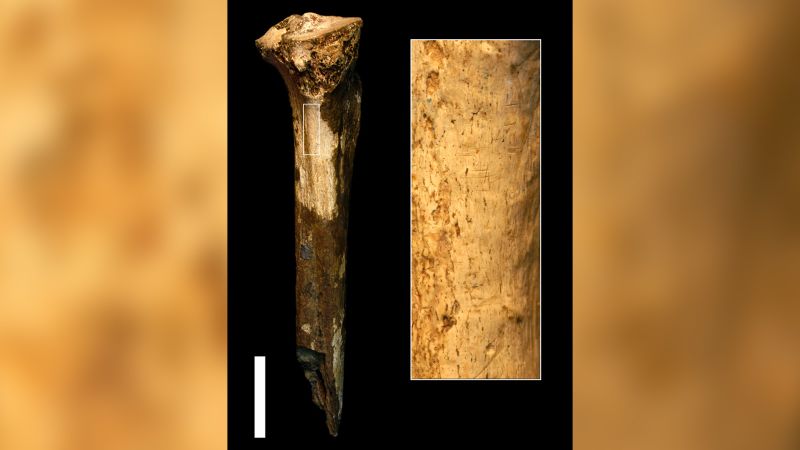Anthropology
Related: About this forumFossil reveals human ancestors butchered one another for reasons beyond ritual
By Katie Hunt, CNN
Updated 5:03 PM EDT, Mon June 26, 2023

Shown here is a view of the fossilized shin bone, left, and the magnified area, right, that reveals cut marks.
Jennifer Clark
Editor’s Note: Sign up for CNN’s Wonder Theory science newsletter. Explore the universe with news on fascinating discoveries, scientific advancements and more.
CNN
—
Nine cut marks on a fossilized shin bone suggest that ancient human relatives butchered and possibly ate one another 1.45 million years ago, according to a new study.
The fossilized tibia was found in the collection of National Museums of Kenya’s Nairobi National Museum by Briana Pobiner, a paleoanthropologist at the National Museum of Natural History in Washington DC.
Pobiner was studying the collection, looking for bite marks from extinct animals that might have preyed on ancient hominins, when she came across cuts that looked like they had been made by stone tools.
“These cut marks look very similar to what I’ve seen on animal fossils that were being processed for consumption,” Pobiner said in a news release.
“It seems most likely that the meat from this leg was eaten and that it was eaten for nutrition as opposed to for a ritual.”
More:
https://edition.cnn.com/2023/06/26/world/fossilized-bone-may-reveal-ancient-cannibalism-scn/index.html
Judi Lynn
(162,385 posts)1:23 PM
/
BY
NOOR AL-SIBAI
"THIS IS DEFINITELY NOT WHAT I THOUGHT I WOULD FIND."
If you imagine life in the distant past as idyllic, think again. In grim new findings, scientists have found evidence that our ancient human ancestors engaged in cannibalism, at least sometimes.
A new study published in the journal Scientific Reports outlines previously-unnoticed archaeological findings that imply an ancient hominin cut up and ate another in what may now be the oldest-known evidence of cannibalism — though there are still lots of questions about which Homo sapiens relative (or relatives, plural) were involved.
As Smithsonian magazine notes in its look at the study, these stunning conclusions came from distinctive marks on a 1.45 million-year-old shin bone that not only indicate that the bone was cut at the knee in a style used to strip meat, but also that a large cat chewed on it as well.
Beyond those facts, gleaned from remains housed in a Kenyan museum, the situation is open to interpretation, ranging from what exact species of human relative the bone is from to whether it was the same species as the ancient hominin who chopped the other up.
More:
https://futurism.com/neoscope/human-ancestor-bone-cannibalism
Hugh_Lebowski
(33,643 posts)I'm amazed anyone even finds this notable.
Judi Lynn
(162,385 posts)Telltale marks on a bone from an early human’s leg could be the earliest evidence of cannibalism
Brian Handwerk
Science Correspondent
June 26, 2023 5:00 a.m.
Craving the meatiest chunk of the lower leg, a Paleolithic butcher struck again and again with a sharp stone blade, removing flesh from bone with practiced skill. When the job was done, this unknown ancient relative of ours was rewarded with a satisfying feast—from the body of another early human.
A recent discovery in a Kenyan museum—previously unnoticed cut marks on a 1.45-million-year-old shin bone—may be the oldest evidence of ancient human relatives butchering and presumably eating each other. Nine distinctive marks, oriented in the same direction, show repetitive cuts in the place where calf muscle attaches to bone, revealing a stone tool methodology typically used to remove meat. Two bite marks show a big cat also chomped on the bone at some point.
Because only the shin bone survives, researchers can’t say just which ancient species of Homo sapiens relative was cut up and devoured. They also don’t know whether the same species or a different relative stripped and presumably ate the calf muscle. If the two were the same species, the find may represent the earliest known example of cannibalism. If not, the grizzly tableau still represents one evolutionary cousin having another for dinner—and not as a guest.
“We just know that some tool-wielding hominin came and cut meat off of that bone,” says paleoanthropologist Briana Pobiner of the Smithsonian’s National Museum of Natural History, who studies the evolution of human diet. “The most plausible explanation is that they did that to eat it.”
More:
https://www.smithsonianmag.com/science-nature/our-human-relatives-butchered-and-ate-each-other-145-million-years-ago-180982425/
wnylib
(24,405 posts)She described a female chimp grabbing chimp babies from other mothers to feed to her own offspring. The mother's whose babies were taken screeched and tried to fend off the attacking chimp. On one occasion, an alpha male came to the rescue of the mother that he had bred with and saved the baby from being stolen. Since chimps do not usually form pair bonds, it was unusual that the male intervened.
So it looks like our ancestors shared that cannibalism behavioral trait with our nearest ape relatives.